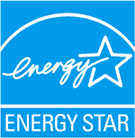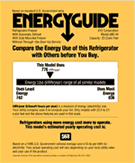Showerheads
Get Rebates,
Incentives & Services
Introduction
Reducing hot water use saves energy because your hot water heater has less work to do. Approximately 73% of the water used in a typical shower is hot water. Inexpensive and simple-to-install, low-flow showerheads and faucet aerators can reduce home water consumption and water heating costs by as much as 50%. Faucet aerators replace the faucet head screen, lowering the flow by adding air to the spray. Low-flow showerheads either draw in air, or have it forced into the water stream by using compressed air. The air-water mixture under pressure creates a high velocity spray, which makes it seem like more water is coming out than there actually is.
Technology Options
The Federal Energy Policy Act of 1992 requires that all faucet fixtures manufactured in the United States restrict maximum water flow at or below 2.5 gallons per minute (gpm) at 80 pounds per square inch (psi) of water pressure or 2.2 gpm at 60 psi. This ensures that most faucet products available will offer at least minimal water efficiency benefits.
There are two main types of low-flow faucets and showerheads: aerating (the most popular) and non-aerating. Aerating mixes air into the water stream. This maintains steady pressure so the flow has an even, full shower spray. Because air is mixed in with the water, the water temperature can cool down a bit towards the floor of the shower. Non-aerating adds a pulse to the water stream; maintaining temperature and delivering a strong spray.
Efficiency Benefits
Standard kitchen and bathroom water faucets use 4 to 7 gallons of water per minute (gpm). This means that a single incidence of washing dishes may consume up to 120 gallons of water. Non-conserving showerheads use 5 to 8 gpm, consuming up to 40 gallons of water for a single five-minute shower.
Simply installing a high-efficiency showerhead and faucet aerator will save about 7,800 gallons of water per year in an average household. An easy-to-install faucet aerator will reduce both the flow rate (from 4 to 7 gpm to 1 to 2.75 gpm) and splashing while increasing areas of coverage. This conserves water and improves faucet performance at the same time. Low-flow heads save more than 12 gallons per shower (a savings of 44% over non-conserving showerheads). Ultra-low-flow heads conserve even more, using only .8 to 1.5 gpm, reducing the average five-minute shower's water usage from 40 to 7.5 gallons.
| Cost-Effectiveness Example | ||||
| Performance | Base Modela | Recommended Level | Best Available | |
| Water Use Only | ||||
| Gallons per minute/cycle | 2.5 gpm | 2.2 gpm | 1.5 gpm | |
| Annual Water Use | 18.250 gallons | 16,060 gallons | 10,950 gallons | |
| Annual Water Cost | $73 | $64 | $44 | |
| Lifetime Water Cost | $590 | $520 | $350 | |
| Electric Water Heating | ||||
| Annual Energy Use | 2,370 kWh | 2,120 kWh | 1,540 kWh | |
| Annual Energy Cost | $142 | $127 | $92 | |
| Lifetime Energy Costb | $1,070 | $960 | $690 | |
| Lifetime Energy and Water Cost Savings | - | $200 | $600 | |
| Gas Water Heating | ||||
| Annual Energy Use | 131 therms | 120 therms | 94 therms | |
| Annual Energy Cost | $53 | $48 | $38 | |
| Lifetime Energy and Water Cost Savings | - | $100 | $350 | |
bLifetime energy cost is the sum of the discounted value of annual energy or water costs, based on average usage and an assumed showerhead life of 10 years. Future energy price trends and a discount rate of 4.1% are based on Federal guidelines (effective from April, 1998 to March, 1999). Future water and wastewater treatment costs are conservatively assumed to increase only at the rate of inflation.
Note: Metric Conversions: 1 gallon = 3.8 liters
By reducing the demand for hot water, a household reduces the amount of energy needed to heat the water. In this way, a low-flow showerhead helps to cut the emission of 376 pounds of climate-changing carbon dioxide each year and a faucet aerator helps to prevent the release of 83 pounds of carbon dioxide per year.
Purchasing Tips
Typically new kitchen faucets will be equipped with a 2.2 gallons per minute (gpm) aerator, while bathroom faucets usually have aerators that restrict flow to 1.5, 1.2, or even 1.0 gpm. If an aerator is already installed on the faucet, it will have its rated flow imprinted on the side. This should read 2.75 gpm or lower. If the flow rate is higher, then it should be replaced. If no aerator is installed, check to see if there are threads just inside the tip of the faucet. Most modern faucets are threaded to accept aerators. For highest efficiency, insist on 1.0 gpm flow restrictors. It is the aerator (the screw-on tip of the faucet nozzle) that ultimately determines the maximum flow rate for water. It's a good idea to bring your old aerator (and any associated washers) to the store when you purchase a new one to ensure that the new aerator will fit on the faucet fixture.
Before 1992, some showerheads had flow rates of 5.5 gpm. Therefore, if you have fixtures that pre-date 1992, you might want to replace them if you're not sure of their flow rates. Here's a quick test to determine whether you should replace a showerhead:
- Place a bucket—marked in gallon increments—under your shower head.
- Turn on the shower at the normal water pressure you use.
- Time how many seconds it takes to fill the bucket to the 1-gallon (3.8 liter) mark.
If it takes less than 20 seconds to reach the 1-gallon mark, you could benefit from a low-flow shower head. Low-flow showerheads and faucet aerators are available at most hardware or plumbing supply stores. Low-flow faucet aerators usually cost $5 to $10. Low-flow showerheads range from $8 to $50. A wide variety of water conserving showerheads is available for purchase with prices starting at $2. A typical handheld massaging showerhead will cost around $25. Designer models cost from $50 to $300 depending on the model and materials used. Hand-held models are more expensive than fixed models.
Use this cost calculator from the U.S. Department of Energy's Federal Energy Management Program (FEMP) to compare the energy costs for your selection with FEMP-recommended and "Best Available" faucets. You can model different scenarios by varying water cost, flow rates, electricity or gas costs and expected usage.
There is a substantial difference in the quality of spray for different showerheads and faucets, even among models with the same flow rate. For spray pattern ratings and other features, refer to Consumer Reports (subscription required).
Emerging Technology
A fairly recent trend in bathroom design could dramatically increase shower water usage. An oversized shower stall with two (or more) showerheads is becoming a popular item in upscale bathrooms across the country — potentially leading to two, three or even four times as much water for showering. Some of these showers have separate controls for each showerhead so that if only one person is showering, only one showerhead is used.
With faucets, there are two designs making their way into homes. A foot pedal faucet controller is simply an on/off switch for your faucet located on the floor. A hands free "leaning" faucet controller has considerably more potential in the residential market. A bar is installed underneath the sink counter as an on/off control for the faucet. The temperature and flow rate of the faucet are still adjusted with the handle, but depressing the bar by leaning against it starts the flow of water. When you move away, a spring pushes the bar out and stops the water flow. The bar also has a locking feature that enables the user to keep the faucet flowing.











